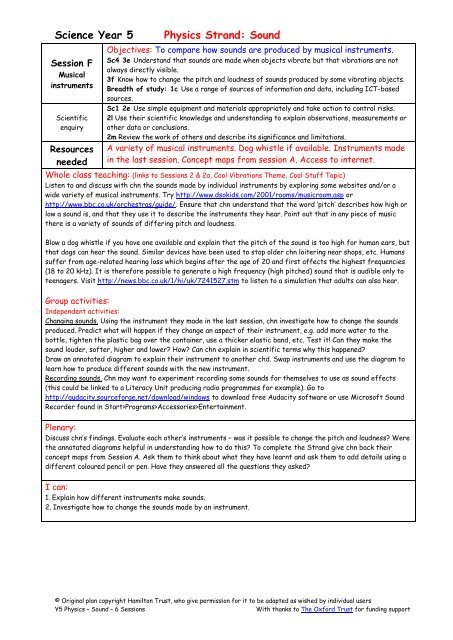Sound - National STEM Centre
Sound - National STEM Centre
Sound - National STEM Centre
Create successful ePaper yourself
Turn your PDF publications into a flip-book with our unique Google optimized e-Paper software.
Science Year 5<br />
Physics Strand: <strong>Sound</strong><br />
Session F<br />
Musical<br />
instruments<br />
Scientific<br />
enquiry<br />
Resources<br />
needed<br />
Objectives: To compare how sounds are produced by musical instruments.<br />
Sc4 3e Understand that sounds are made when objects vibrate but that vibrations are not<br />
always directly visible.<br />
3f Know how to change the pitch and loudness of sounds produced by some vibrating objects.<br />
Breadth of study: 1c Use a range of sources of information and data, including ICT-based<br />
sources.<br />
Sc1 2e Use simple equipment and materials appropriately and take action to control risks.<br />
2l Use their scientific knowledge and understanding to explain observations, measurements or<br />
other data or conclusions.<br />
2m Review the work of others and describe its significance and limitations.<br />
A variety of musical instruments. Dog whistle if available. Instruments made<br />
in the last session. Concept maps from session A. Access to internet.<br />
Whole class teaching: (links to Sessions 2 & 2a, Cool Vibrations Theme, Cool Stuff Topic)<br />
Listen to and discuss with chn the sounds made by individual instruments by exploring some websites and/or a<br />
wide variety of musical instruments. Try http://www.dsokids.com/2001/rooms/musicroom.asp or<br />
http://www.bbc.co.uk/orchestras/guide/. Ensure that chn understand that the word ‘pitch’ describes how high or<br />
low a sound is, and that they use it to describe the instruments they hear. Point out that in any piece of music<br />
there is a variety of sounds of differing pitch and loudness.<br />
Blow a dog whistle if you have one available and explain that the pitch of the sound is too high for human ears, but<br />
that dogs can hear the sound. Similar devices have been used to stop older chn loitering near shops, etc. Humans<br />
suffer from age-related hearing loss which begins after the age of 20 and first affects the highest frequencies<br />
(18 to 20 kHz). It is therefore possible to generate a high frequency (high pitched) sound that is audible only to<br />
teenagers. Visit http://news.bbc.co.uk/1/hi/uk/7241527.stm to listen to a simulation that adults can also hear.<br />
Group activities:<br />
Independent activities:<br />
Changing sounds. Using the instrument they made in the last session, chn investigate how to change the sounds<br />
produced. Predict what will happen if they change an aspect of their instrument, e.g. add more water to the<br />
bottle, tighten the plastic bag over the container, use a thicker elastic band, etc. Test it! Can they make the<br />
sound louder, softer, higher and lower? How? Can chn explain in scientific terms why this happened?<br />
Draw an annotated diagram to explain their instrument to another chd. Swap instruments and use the diagram to<br />
learn how to produce different sounds with the new instrument.<br />
Recording sounds. Chn may want to experiment recording some sounds for themselves to use as sound effects<br />
(this could be linked to a Literacy Unit producing radio programmes for example). Go to<br />
http://audacity.sourceforge.net/download/windows to download free Audacity software or use Microsoft <strong>Sound</strong><br />
Recorder found in Start>Programs>Accessories>Entertainment.<br />
Plenary:<br />
Discuss chn’s findings. Evaluate each other’s instruments – was it possible to change the pitch and loudness? Were<br />
the annotated diagrams helpful in understanding how to do this? To complete the Strand give chn back their<br />
concept maps from Session A. Ask them to think about what they have learnt and ask them to add details using a<br />
different coloured pencil or pen. Have they answered all the questions they asked?<br />
I can:<br />
1. Explain how different instruments make sounds.<br />
2. Investigate how to change the sounds made by an instrument.<br />
© Original plan copyright Hamilton Trust, who give permission for it to be adapted as wished by individual users<br />
Y5 Physics – <strong>Sound</strong> – 6 Sessions<br />
With thanks to The Oxford Trust for funding support
















